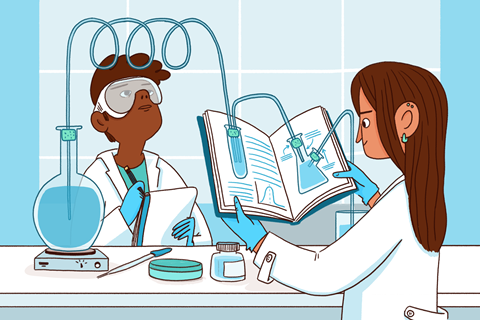The expectation is that chemistry lessons include hands on activities, but to be of value, practical work has to have purpose
‘Are we doing a practical today?’ or ‘Are we using Bunsen burners today sir?’ is often the first question on students’ lips. If only I had a pound for every time I was asked! As science teachers we do practical work. There is pressure to do practicals from students, from tradition, even from our peers; there is an expectation that we do practicals. When we are doing practicals, we must ensure we maximise student learning from them.

What are they going to learn?
A good starting point when considering maximising learning during practical work is to use the ideas from Robin Millar and his collaborators at the University of York. He promotes a ‘hands on/minds on’ way of thinking. Hands on is what students are going to do with objects and equipment, and minds on is what they are going to do with ideas to show their understanding.
Before I order the equipment for a practical I have an outline in my head as to what the students are going to learn from the practical. It could be that the learning point is a hands on one: following instructions, manipulating equipment, collecting and recording data, looking for patterns. Alternatively, it could be a minds on outcome: can they use the correct vocabulary in describing their experiment, could they identify the dependent variables, or the products of redox reactions? Similarly can they show their understanding by linking their analysed data/observations to a scientific theory? For example explaining their results using the kinetic theory, making predictions before an experiment and then making further predictions in novel contexts (how will further examples of metals react, or predicting the products made in electrolysis, from a variety of salt solutions?). A good place to look for these is the ‘working scientifically’ section of the syllabus. Clearly some of these are more challenging than others and lower down the school you may find a natural tendency to focus on hands on outcomes. But even here there could be a minds on idea for students to consider.
7 simple rules to boost science teaching
Click to expand and explore the rules
Build on the ideas that pupils bring to lessons
Help pupils direct their own learning
Use models to support understanding
Support pupils to retain and retrieve knowledge
- Pay attention to cognitive load—structure tasks to limit the amount of new information pupils need to process
- Revisit knowledge after a gap to help pupils retain it in their long-term memory
- Provide opportunities for pupils to retrieve the knowledge that they have previously learnt
- Encourage pupils to elaborate on what they have learnt
Use practical work purposefully and as part of a learning sequence
Develop scientific vocabulary and support pupils to read and write about science
Use structured feedback to move on pupils’ thinking
Seeing the wood for the trees
Once you have decided upon the learning outcome, how do you ensure students focus on this and don’t get lost in the practical details? I have stopped doing certain practicals, or at least tend to do them as a teacher demonstration because the sheer challenge of performing the experiment was so great, few students ever saw the learning outcome. They got lost with test tubes, pipettes and instructions. Or the practical took so long there wasn’t time at the end for proper discussion. I try to train my students to ‘get on with practical work’. I don’t let them get into the mindset that I will allow enough time for everyone to finish; I allow only the time to collect enough results to discuss as a class.
Remembering what goes where and when can be made easier with integrated instructions. These clearly link visual cues with the instructions. They can help reduce the cognitive load of a practical and help students focus on your intended learning point.
Download an example and template to help you define the intended outcomes of practical work as MS Word or pdf.
Final thoughts
In some quarters practical work in science lessons is under pressure. Constrained budgets and a focus on exam results are leading some teachers to question whether to do class experiments. As John Holman says in the Good practical science report: ’Professional scientists are vociferous in their long-standing support of practical work’ and he shows a link between practical work and future engagement with STEM subjects. We can never tell when one of our chemistry practicals could lead to a future career in science.
This article is part of the series 7 simple rules for science teaching, developed in response to the EEF’s Improving secondary science guidance. It supports rule 5b, Sequence practical activities with other learning.
Downloads
Defining intended outcomes
Word, Size 52.06 kbDefining intended outcomes
PDF, Size 52.38 kb












1 Reader's comment